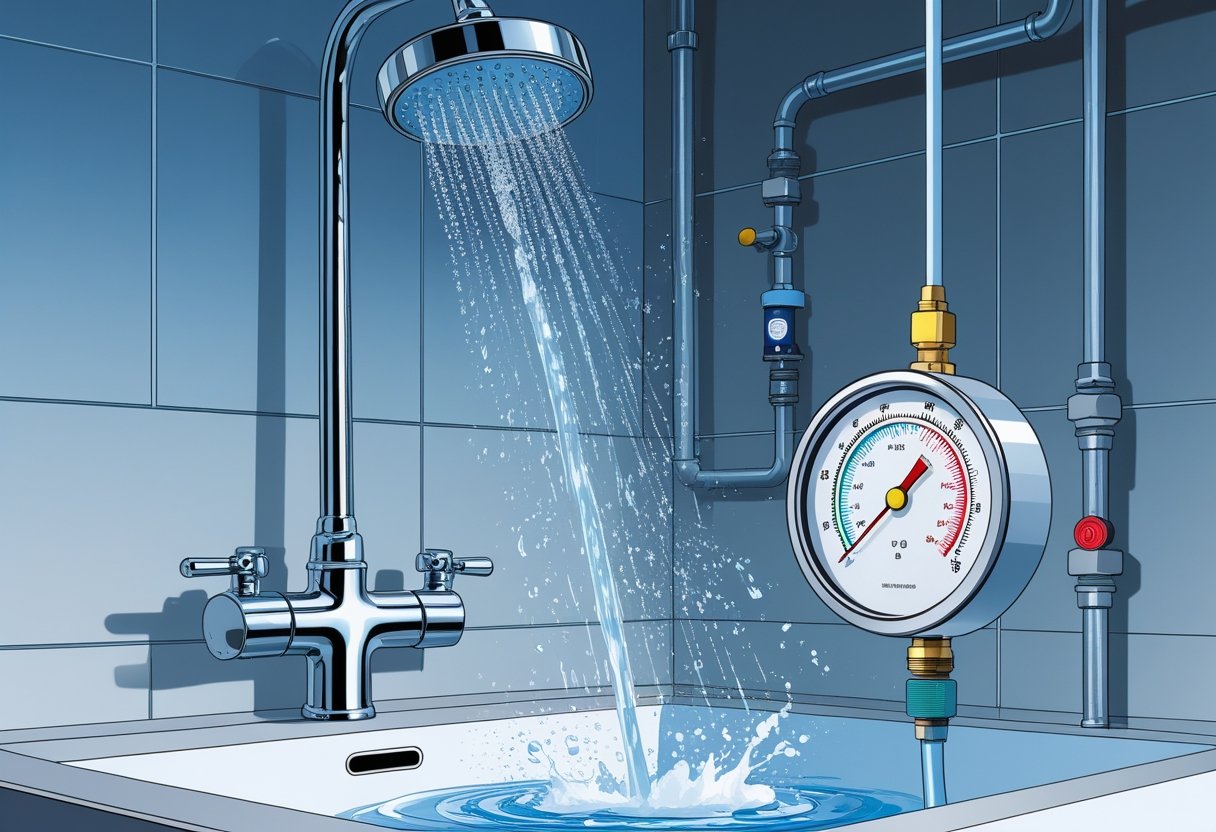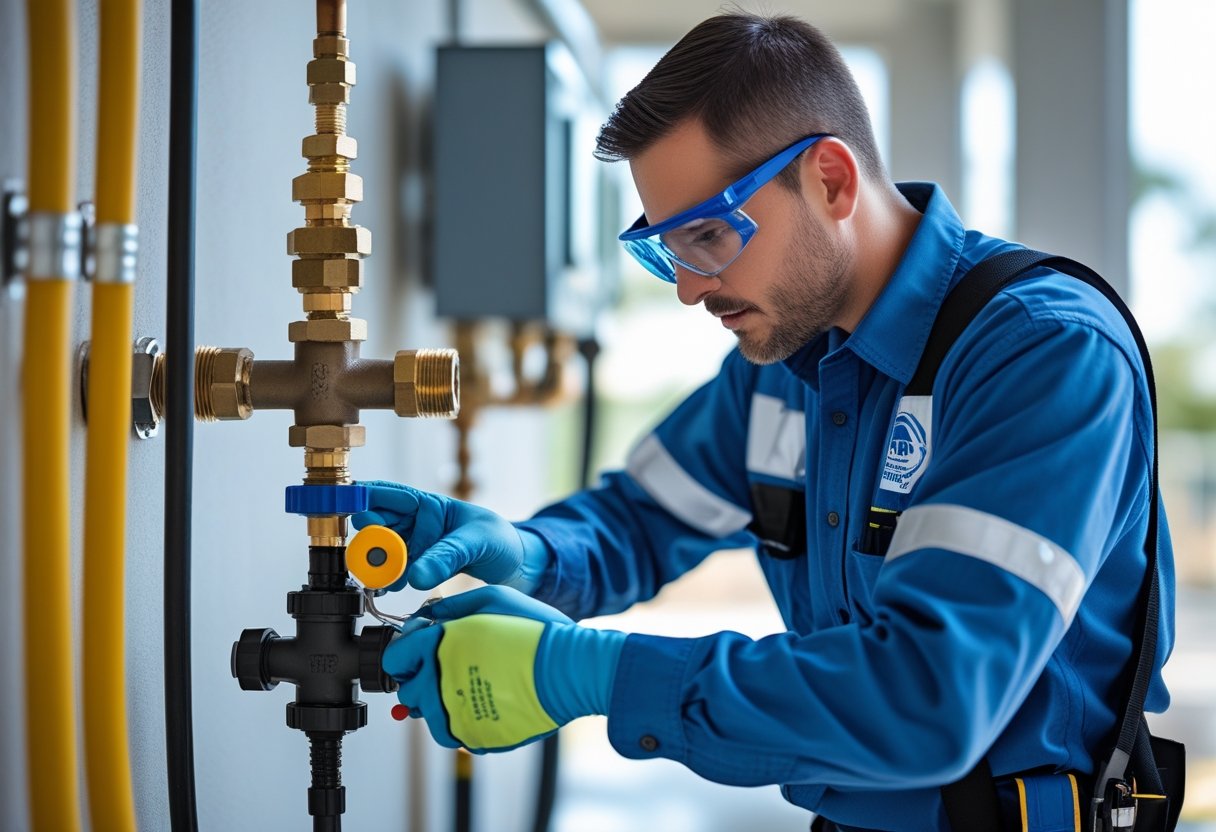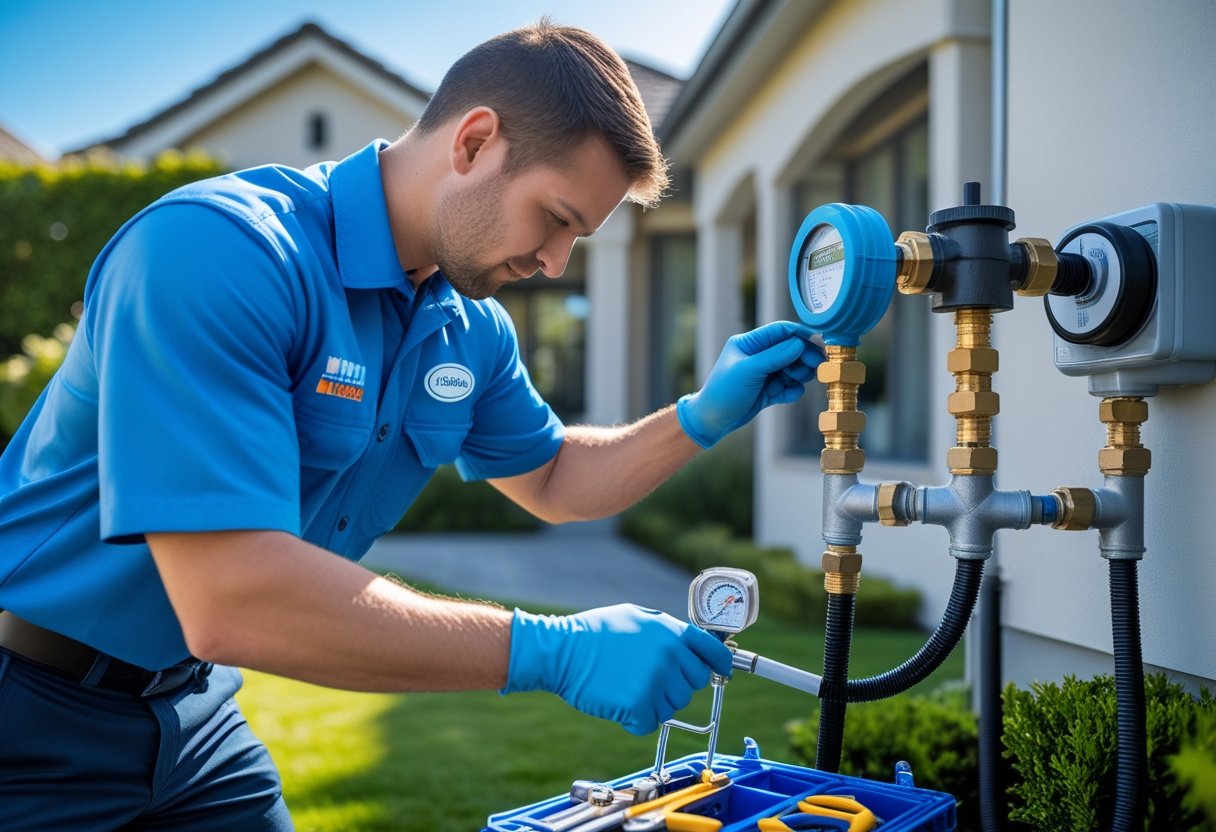High water pressure can lead to significant damage in your plumbing system, resulting in costly repairs and inefficiencies. You can tell if your water pressure is too high by noting signs such as clanging pipes, running toilets, or unusually high water bills. Recognizing these indicators early can save you from future headaches and expenses.
In San Diego County, many homeowners may not realize the importance of monitoring their water pressure. If left unchecked, excessive pressure can lead to leaks, water damage, and even a decrease in appliance lifespan. At Pacific Backflow, we emphasize the need for regular checks and the installation of backflow preventers to ensure a safe and efficient plumbing system.
Keeping your plumbing in optimal condition is essential. By being aware of high water pressure signs, you can take proactive steps to protect your home. If you’re experiencing these issues, consider reaching out to Pacific Backflow for expert assistance in maintaining your water system.
Key Signs Your Water Pressure Is Too High
High water pressure can lead to serious plumbing issues in your home. Recognizing the signs early can save you from costly repairs and inconveniences. Below are some key indicators that your water pressure may be too high.
Banging or Clanging Pipes
If you hear loud banging sounds when you turn off a faucet or appliance, this is a clear sign of high water pressure, often referred to as "water hammer." This occurs when water suddenly stops or changes direction, causing pipes to vibrate and create noise.
Continued exposure to these conditions can damage your plumbing, leading to leaks or even burst pipes. If this happens frequently, it's wise to check your water pressure levels. Consider using a pressure gauge to monitor the situation and ensure they remain within the safe range of 40-60 psi.
Leaking Faucets or Fixtures
Leaking faucets and fixtures can indicate high water pressure. When pressure is too high, it puts excessive force on seals and washers, leading to leaks. You may notice dripping from your faucets, showerheads, or even water pooling around fixtures.
Not only do leaks waste water, but they can also increase your utility bills significantly. If you observe persistent leaks, it might be time to have your water pressure checked. Regular inspections can help you avoid larger plumbing issues down the road.
Constantly Running Toilets
A toilet that runs non-stop can be a frustrating issue and is often linked to high water pressure. When pressure is elevated, the fill valve may not function correctly, causing water to continuously flow into the tank.
This not only wastes water but can also spike your water bills. If you hear your toilet running frequently, check the water pressure in your home. Addressing high pressure can resolve this problem and save you money in the long run.
Sudden Pressure Changes
Experiencing sudden fluctuations in water pressure while using water? This can be another indication of high water pressure. You may notice that it becomes either too strong or too weak without warning. Such variations can lead to appliance malfunctions, such as dishwashers or washing machines failing to operate correctly.
Monitoring your water pressure regularly can help you catch these changes and address them before they escalate. If you’re experiencing these symptoms, reach out to a plumbing professional. At Pacific Backflow, we understand the importance of maintaining optimal water pressure and can provide solutions tailored to your home's needs.
Effects of Excessive Water Pressure
Excessive water pressure can create significant issues within your plumbing system. It can lead to water damage, cause appliances to fail, and increase your utility bills. Understanding these effects is crucial for maintaining a healthy home environment.
Water Damage and Leaking Pipes
High water pressure can lead to leaks in your plumbing system. When pressure exceeds normal levels, joints and seals within pipes become compromised.
Signs of leaking pipes include:
- Water stains on walls or ceilings
- Mold or mildew growth
- Puddles around appliances
Damage can escalate quickly, resulting in costly repairs if left untreated. Regular monitoring of your water pressure is essential to prevent these issues.
Damaged Household Appliances
Residential appliances such as dishwashers, washing machines, and water heaters are built to operate under specific pressure limits. When the pressure is too high, these units can experience premature wear and tear.
For example, dishwashers may develop leaks, while washing machines might fail to fill properly. Water heaters can also be affected, leading to potential failures. Protect your investment by ensuring your water pressure stays within safe limits.
Increased Utility Bills
Another consequence of excessive water pressure is rising utility bills. When pressure is higher than necessary, more water is used, resulting in increased consumption.
This can lead to:
- Higher costs on your monthly water bill
- Increased maintenance needs for appliances
- Additional strain on your plumbing system, which could require costly repairs
Monitoring your water pressure can help you keep these costs in check. If you suspect your water pressure is too high, consider consulting with a professional service like Pacific Backflow for assistance.
How To Test Your Water Pressure
Testing your water pressure is essential for maintaining your plumbing system. Knowing whether your water pressure is too high or too low can help you prevent plumbing issues and ensure efficient water flow in your home. Here are two reliable methods to test your water pressure.
Using a Water Pressure Gauge
To accurately measure your water pressure, you'll need a water pressure gauge. This tool is easy to find at hardware stores and typically screws onto a standard faucet or hose bib.
- Preparation: Ensure no water is running in your home, including faucets, washing machines, or dishwashers. This gives the best reading.
- Attachment: Screw the gauge onto the chosen faucet, ensuring a tight fit to avoid leaks.
- Testing: Turn the faucet on fully. The gauge will display the water pressure in pounds per square inch (psi). The normal range for home water pressure is between 40-60 psi.
If the reading exceeds this range, consider consulting a professional, such as Pacific Backflow, for adjustments and solutions to prevent potential plumbing issues.
Testing Without a Gauge
If you don’t have a water pressure gauge handy, you can still approximate your water pressure using a simple method.
- Fill a Container: Use a one-quart container, like a jug, and turn on an outdoor faucet at full blast.
- Measure Time: Time how long it takes to fill the container. If it takes less than 30 seconds to fill, you likely have high water pressure.
- Flow Observation: If the flow is weak and takes longer to fill, this may indicate low water pressure.
While this method is less precise, it can give you a general idea of your water pressure in the house. For accurate results and solutions, contact a service like Pacific Backflow to evaluate your system.
Understanding Normal and Ideal Water Pressure
Recognizing the range and implications of water pressure in your plumbing system is vital for efficient functioning. You need to know what constitutes normal and ideal water pressure to ensure your home operates smoothly without stress on the plumbing elements.
Normal Water Pressure Range
The normal water pressure range for residential properties generally falls between 40 psi and 70 psi. Most homeowners find that pressures around 50-60 psi provide optimal performance. Pressures below 40 psi may result in low water flow, affecting showers and faucets, while pressures above 80 psi can lead to plumbing issues.
To test your water pressure at home, you can use a water pressure gauge attached to an outdoor faucet. This provides a quick and accurate measurement, helping you determine if adjustments or professional evaluation is necessary.
Risks of High and Low Water Pressure
Both high and low water pressure can pose significant risks to your plumbing system. Low water pressure can lead to inadequate flow, making household tasks cumbersome. This may happen due to clogged pipes or faulty fixtures.
Conversely, high water pressure can cause serious damage over time. Burst pipes, leaking fixtures, and appliance malfunctions are common consequences. High pressure increases wear on your plumbing, leading to costly repairs. Regular monitoring is essential to avoid these issues.
What Is Ideal Water Pressure
The ideal water pressure for the average home is generally between 50 psi and 60 psi. This range ensures efficient water delivery without stressing the plumbing system. If your readings consistently fall outside of this range, consider reaching out to experts like Pacific Backflow for evaluation and possible adjustments.
Using devices like pressure regulators can help maintain ideal levels. Understanding water pressure’s implications and actively managing it protects your home’s plumbing and appliances over the long term. Regular backflow testing by professionals can also ensure that your system remains compliant and functions effectively.
Addressing High Water Pressure Issues
High water pressure can lead to various plumbing problems within your home. Taking the proper steps to address and manage this issue is essential for maintaining your plumbing system. Below are methods to adjust the pressure, know when to call a professional, and maintain your plumbing.
Adjusting or Installing a Pressure Regulator
A water pressure regulator is a vital device for controlling and maintaining safe water pressure levels. If your water pressure is consistently high, adjusting or installing this regulator can significantly mitigate potential damage. Begin by locating the regulator, typically positioned near your main water supply.
Check the manufacturer’s guidelines for optimal pressure settings. If adjusting the regulator does not yield satisfactory results, you may need a professional installation. Companies like Pacific Backflow specialize in installing pressure regulators that ensure compliance with local codes, providing peace of mind regarding your plumbing system's safety.
When To Contact a Plumber
If you've tried adjusting your pressure regulator without success, it may be time to contact a plumber. You should seek professional plumbing services if you notice ongoing issues such as leaks, bursts, or strange noises from your pipes.
A qualified plumber can perform a comprehensive inspection of your plumbing system, identifying any underlying issues or necessary repairs. They have the expertise to resolve complex problems that could arise from high water pressure and can recommend necessary upgrades or repairs for your home.
Maintaining Your Plumbing System
Regular maintenance is crucial for preventing high water pressure. Be proactive by monitoring your system frequently for signs of wear and tear. Schedule routine inspections to identify potential issues before they become major problems.
Make sure to replace worn-out fixtures and promptly address any leaks. Partnering with a reliable backflow service, such as Pacific Backflow, for annual maintenance ensures your plumbing system operates within safe parameters. Proper care not only prolongs the life of your plumbing but also maintains the safety of your water supply.
Frequently Asked Questions
Understanding water pressure in your home is crucial for maintaining your plumbing system. This section addresses common inquiries regarding the indicators, causes, and solutions related to excessive water pressure.
What are the indicators of excessive water pressure in household plumbing?
You may notice specific signs that indicate high water pressure. These include frequent leaking faucets, banging pipes, and running toilets. Additionally, if water sprays from the faucet or showerhead, it can also signal increased pressure in your system.
What could cause a sudden increase in water pressure within my home?
A sudden spike in water pressure is often due to external factors. Municipal supply changes can raise pressure levels, especially if they adjust settings for firefighting or other needs. Additionally, a malfunctioning pressure regulator or leaks in your plumbing system can contribute to these fluctuations.
How can I resolve issues with high water pressure in my residence?
To address high water pressure, consider installing a water pressure regulator. This device can help manage the pressure entering your home, ensuring it remains within safe limits. If you're unsure how to proceed, consulting professionals like those at Pacific Backflow can provide the expertise needed for your situation.
What are the potential risks of having high water pressure in my plumbing system?
High water pressure poses several risks to your plumbing system. It can lead to premature wear on pipes and fixtures, increasing the likelihood of leaks or ruptures. Additionally, appliances connected to your water system may fail sooner than expected, resulting in costly repairs.
How can one assess water pressure in a home without using specialized tools?
You can perform a basic assessment of your water pressure using simple methods. Observe if water comes out forcefully from faucets or fixtures. You can also fill a gallon container; if it fills in under 30 seconds, your pressure might be too high.
What sensations or signs might suggest that the water pressure in my home is too strong?
If you feel vibrations or hear banging noises in your pipes when water is running, these can indicate excessive pressure. You may also notice difficulty in controlling faucet flow rates or find that water sprays unexpectedly from hoses or fixtures.












